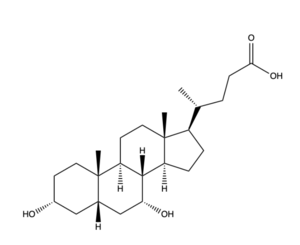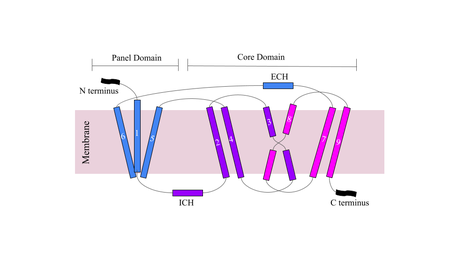Sandbox Reserved 1783
From Proteopedia
(Difference between revisions)
| Line 23: | Line 23: | ||
| - | [[Image:Patches.png|300 px| | + | [[Image:Patches.png|300 px|right|thumb|'''Figure 2.''' Surface representation of the NTCP molecule with both patches shown. Patch 1 can be seen on the left side of the molecule, whereas patch 2 is located on the right side within the binding tunnel. [PDB file 7ZYI].]] |
=== Conformation Change === | === Conformation Change === | ||
| Line 43: | Line 43: | ||
=== Bile Salt Uptake === | === Bile Salt Uptake === | ||
| - | Cirrhosis, commonly known as the last stage of liver disease, is due to a deficiency in the bile acid supply in the liver. Bile acid pools, as defined by Vlahcevic, are the negatively-charged precursors to bile and often are conjugated to positively-charged bile salts. This is attributed either a decrease in the production of bile salts or a large increase in the excretion of this molecule out of the cell. https://www.gastrojournal.org/article/S0016-5085(71)80053-7/ | + | [https://www.niddk.nih.gov/health-information/liver-disease/cirrhosis/definition-facts Cirrhosis], commonly known as the last stage of liver disease, is due to a deficiency in the bile acid supply in the liver. Bile acid pools, as defined by Vlahcevic, are the negatively-charged precursors to bile and often are conjugated to positively-charged bile salts. This is attributed either a decrease in the production of bile salts or a large increase in the excretion of this molecule out of the cell. <Ref name="Cirrhosis"> Vlahcevic, Z., Buhac, I., et al. Bile Acid Metabolism in Patients with Cirrhosis. Gastroenterology vol. 60, 491-498 (1971). [https://www.gastrojournal.org/article/S0016-5085(71)80053-7/fulltext DOI: 10.1016/S0016-5085(71)80053-7]. </Ref> Cirrhosis causes symptoms such as jaundice, abdominal pain and swelling, and swelling of the legs and feet. A patient who has type two diabetes, men, and those who have or do abuse alcohol are also more sustainable to developing Cirrhosis. This diagnosis can lead to liver failure and other life-threatening diseases, making bile salt uptake essential to liver function. |
| + | |||
</StructureSection> | </StructureSection> | ||
== References == | == References == | ||
<references/> | <references/> | ||
Revision as of 20:02, 10 April 2023
| This Sandbox is Reserved from February 27 through August 31, 2023 for use in the course CH462 Biochemistry II taught by R. Jeremy Johnson at the Butler University, Indianapolis, USA. This reservation includes Sandbox Reserved 1765 through Sandbox Reserved 1795. |
To get started:
More help: Help:Editing |
Sodium Taurocholate Co-Transporting Peptide
| |||||||||||
References
- ↑ 1.0 1.1 1.2 Goutam, K., Ielasi, F.S., Pardon, E. et al. Structural basis of sodium-dependent bile salt uptake into the liver. Nature 606, 1015–1020 (2022). DOI: 10.1038/s41586-022-04723-z.
- ↑ Maldonado-Valderrama, J., Wilde, P., Macierzanka, A., & Mackie, A. (2011). The role of bile salts in digestion. Advances in colloid and interface science, 165(1), 36–46. DOI: 10.1016/j.cis.2010.12.002.
- ↑ 3.0 3.1 Asami J, Kimura KT, Fujita-Fujiharu Y, Ishida H, Zhang Z, Nomura Y, Liu K, Uemura T, Sato Y, Ono M, Yamamoto M, Noda T, Shigematsu H, Drew D, Iwata S, Shimizu T, Nomura N, Ohto U. Structure of the bile acid transporter and HBV receptor NTCP. Nature. 2022 Jun; 606 (7916):1021-1026. DOI: 10.1038/s41586-022-04845-4.
- ↑ 4.0 4.1 Xiangbing Qi, Wenhui Li. (2022). Unlocking the secrets to human NTCP structure. The Innovation, Vol. 3, Issue 5. 100294, ISSN 2666-6758, DOI: 10.1016/j.xinn.2022.100294.
- ↑ Liu, H., Irobalieva, R.N., Bang-Sørensen, R. et al. Structure of human NTCP reveals the basis of recognition and sodium-driven transport of bile salts into the liver. Cell Res 32, 773–776 (2022). DOI: 10.1038/s41422-022-00680-4.
- ↑ Vlahcevic, Z., Buhac, I., et al. Bile Acid Metabolism in Patients with Cirrhosis. Gastroenterology vol. 60, 491-498 (1971). DOI: 10.1016/S0016-5085(71)80053-7.
![Figure 1. NTCP structure with both Na+ ions and bile salts bound with the NTCP molecule shown in light blue, the two Na+ ions shown in purple spheres, and the bile salts shown in sticks as dark blue. [PDB file 7ZYI].](/wiki/images/thumb/3/36/Fig_1.png/400px-Fig_1.png)

![Figure 2. Surface representation of the NTCP molecule with both patches shown. Patch 1 can be seen on the left side of the molecule, whereas patch 2 is located on the right side within the binding tunnel. [PDB file 7ZYI].](/wiki/images/thumb/8/8c/Patches.png/300px-Patches.png)


